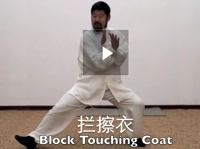Mini lesson on one move at a time principle to avoid double heavy.
Presenter: Chen Zhonghua Length: 6 min. In: English Year: 2013 Difficulty:1/5 At:Iowa
“Segmented Moves” Online Video Trailer
Previous post: Upper Midwest (Iowa) Practical Method Gathering August 9
Next post: Ottawa Workshop Demo



{ 3 comments… read them below or add one }
A very important way of moving that makes you not double heavy and actually do Taiji!
This method of movement is very much like loading an old muzzle loading gun to prepare it for firing. One must go through sequential steps in a precise manner in order to be able to finally aim and fire the gun. Powder, wads and bullet must be placed and ramrodded into position, The flint checked or tinder primed before aiming and pulling the trigger. If any part is left undone, disaster can occur- if anything other than the trigger is squeezed or the body moves, the aim will be off and the bullet will miss its mark. If the aim is accurate, the trigger squeezed then everything works and there is a tremendous release of energy that propels the bullet out of the non moving gun barrel. In this way, sequential movements in Taiji work to produce and control the correct movement of energy in the body and out to the opponent. Practice segmented movement to improve your Taiji (and don’t play with guns!)
That’s awesome Allan.
Segmented moves avoid double heavy. Why? When we only move one part at a time, there is something else not moving. The two parts are not moving at the same time, and therefore, it is separated. Separation means no double heavy. It can be “moving hand and not moving waist”, or “moving waist and not moving hand”. By “moving”, I mean to move from Point A to Point B. That’s why we perform our yilu in a robot fashion, in order to train the ability to move any of our body parts at will without affecting another part that shouldn’t be affected in an involuntary way.